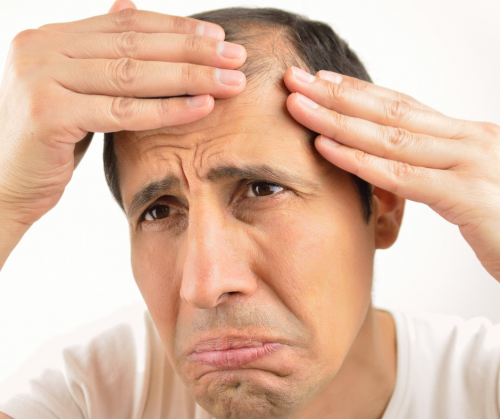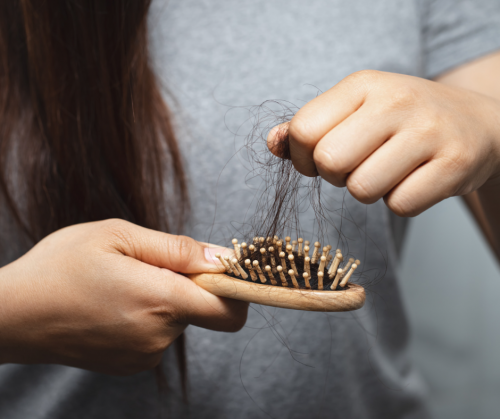With Dr. Kaarthig Ganesamoorthy (DTAP Clinic)

Study reveals that male pattern hair loss can start in the late teens or early twenties. Commonly, it appears in the 50s with visible signs of hair thinning, balding or receding hairline. Male pattern baldness happens as hormone levels change over a person’s lifetime. Research has found that male pattern baldness is associated with male sex hormones called androgens. Unexpected or sudden hair loss may indicate a health condition and would require medical attention.

Male pattern baldness happens as hormone levels change over a person’s lifetime.
What is male pattern hair loss?
Androgenetic alopecia is a common form of male hair loss.
A follicle is a tiny hole that each strand of hair sits in. Balding occurs when the hair follicle shrinks resulting in shorter and finer hair over time. This results in a follicle not being able to accommodate new hair growth, though it still remains alive and has the potential to grow hair with proper treatment.
A familial tendency to MAA and racial variation in the prevalence is well recognized, with heredity accounting for approximately 80% of the predisposition. Normal levels of androgens are sufficient to cause hair loss in genetically susceptible individuals.
The balding pattern tends to be a gradual process beginning in early adulthood in some cases. It usually starts off as a receding hairline, and or bald spot on the top of the head.
The most common hair loss in men is Male Androgenetic Alopecia (MAA). 30%-50% of men are affected by the age of 50 in this case. MAA usually occurs in the temples, vertex and mid-scalp. These are highly reproducible patterns.
Is hair thinning reversible?
Reversible is a difficult term to come to grips with if we are only focusing on natural remedies for hair loss prevention. It is definitely possible to slow down the rate of thinning hair though.
You may try these tips to help prevent hair loss in men:
- Find ways to lower your stress levels.
- Take care of your overall health with a healthy diet and exercise.
- Avoid hairstyles that tug and pull on your hair.
- Use hair products to prevent hair loss.
- Avoid smoking.
- Try scalp massages.
Can crown hair loss be treated?
Yes, by the following options. Each has its advantages and disadvantages. Ultimately, this is a personal choice and will depend on what your goal here is.
Platelet-rich plasma (PRP): While PRP is not a permanent solution, maintenance treatments can help you maintain results.
PRP can be used alone or given before a hair transplant to improve results.
If your dermatologist recommends PRP for you, here’s what you can expect. A small amount of your blood would be drawn and placed into a machine that separates your red blood cells from the plasma.
Your plasma is then injected into your scalp. This takes about 10 minutes.
You will need to return for more injections. For the first three months, you return once a month. Then you return once every three to six months.
Within a few months, PRP can help lessen hair loss. Soon after, some patients see a thickening of their hair or regrowth.
Hair transplant: If you’re looking for a permanent solution, you may want to consider a hair transplant. This procedure no longer involves moving plugs of hair from one part of your scalp to another. Today, a hair transplant can give you permanent, natural-looking results.
How can I regain my lost hair?
Nutrition and hair products are the two things that we need to look at closely to slow down the rate of hair thinning. The genetic factor is not something we can alter.
It is important to know that hair products should not be excessively rubbed into your scalp. There are certain hair oils that we use to massage the scalp, but apart from that, things like hair gel, mousse, and hair cream should be applied in a way that it does not sit on the scalp but rather just the hair.

Nutrition and hair products are the two things that we need to look at closely to slow down the rate of hair thinning.
What studies show: In clinical trials, minoxidil has been shown to reduce hair loss, stimulate hair growth, and strengthen existing strands of hair. While minoxidil can help, you’re unlikely to see full regrowth.
How to use: Apply to your scalp.
When to use: Minoxidil is applied twice a day, every day.
How long it takes to see results: Some men respond to minoxidil better than others, and some men fail to see any difference. If minoxidil works for you, it can take up to six to 12 months to see results. It’s important to follow directions, which includes applying minoxidil every day.
Possible side effects: When using minoxidil, some men develop an irritated scalp. The newer formulation, which is a foam, seems to reduce this risk. Other possible side effects include an itchy scalp or headaches.
If you stop using minoxidil: When you stop applying minoxidil, you lose its benefits. Because minoxidil helps you maintain your hair’s thickness, some hairs may look and feel thinner. You’ll also gradually notice that you’re shedding more hair.
What studies show: Finasteride has been shown to slow down further hair loss in about 80% to 90% of men taking it. Some men also see some hair regrowth, which tends to occur in men who start finasteride when they first notice signs of hair loss.
How to use: Take a pill.
When to take: Every day.
How long it takes to see results: If finasteride helps you, you will start to see results in about 6 months.
Possible side effects: Some men who take finasteride have developed side effects. These include loss of libido (desire to have sex), inability to get or keep an erection, swelling and tenderness in their breasts, and depression. It’s been reported that sexual side effects can continue after a patient stops taking finasteride. Due to the seriousness of these side effects, your dermatologist will want to know more about you before prescribing finasteride. Your dermatologist will give you a complete exam and ask you about preexisting conditions and medications you take.
Can be used alone: If finasteride is part of your treatment plan, you may take it alone or use it along with minoxidil.
If you stop taking finasteride: To maintain results, you must continue taking one pill every day. Once you stop taking this medication, hair loss returns.
(Ref: https://www.aad.org/public/diseases/hair-loss/treatment/male-pattern-hair-loss-treatment)
For further information about hair loss or for a discreet consultation with Dr Kaarthig Ganesamoorthy, please visit www.dtapclinic.com.my
Services
Stakeholder mapping, analysis, engagement and communication needs to be detailed to avoid business losses or even worse, a crisis. How can you do this effectively to prevent failure? ...
Data-driven business decisions have never been as crucial, especially in this era. MGBF leverages off, technology, experience and market presence to aid businesses in making accurate decisions. ...
MGBF provides comprehensive strategic advice and results-focused solutions to solve clients' problems in business-government relations so they can focus on their core business. ...
A critical business challenge is meeting the right decision-makers and potential buyers through the best channel and platform. How will you improve your business competency? ...
Upcoming Events
MGBF founding chairman Nordin Abdullah and UMW Toyota president Datuk Ravindran K. will delve into the convergence of automotive innovation and environmental sustainability in Penang, Sarawak, Johor and Pahang.
Hosted by menumiz™ – an end-to-end restaurant management system – this roundtable will feature a case study presentation and a panel session to discuss the latest digital trends, challenges, and opportunities within the food and beverage sector.
In this episode of 'A Working Lunch with Nordin', MGBF's founding chairman, Nordin Abdullah, will host this discussion focusing on the biggest threats and opportunities for businesses as we look to manage change in the South China Sea.
This MGBF Roundtable will focus on regional food security issues and trends in the regional supply chain, and trade regulations and policies, including a new geopolitical tool i.e., weaponisation of supply chains.
MGBF In The News

Planet QEOS, KIS BlOCNG San Bhd, and the Sarawak Land Consolidation and Rehabilitation Authority (SALCRA) have officially signed a tripartite memorandum of understanding (MoU) to establish a collaborative framework aimed at producing bio-hydrogen via the Steam Biomethane Reforming (SBMR) Process. The MoU was signed by Planet QEOS executive chairman Dino […]

Planet QEOS and China Machinery Engineering Corporation (CMEC) are interested in investing RM10 billion to co-develop advanced Megawatt peak (MWp) agrovoltaic in Baram, to further boost Sarawak’s green energy initiative and food security. Sarawak Premier Datuk Patinggi Tan Sri Abang Johari Tun Openg was briefed on Friday by both the […]

Last week SPM results came out, 373,974 aspirants who have been waiting patiently over the last few months would now know their fate. Some 10,109 have received all A’s, the golden standard of academic success and the ticket to those looking to study the “more advanced” subjects in university. Proudly, […]

The classic knee-jerk reaction is to say, fire the coach, change the leadership of associations, and reduce the funding till they start performing better. This kind of negative reinforcement may work for kindergarten children, but we are dealing with high-performance adults – individuals much further along in their psychological and […]

Since its earliest tea plantations in 1929, Cameron Highlands has grown to become a key player in the agricultural landscape of Malaysia, producing 40 per cent of all vegetables grown. Despite Malaysia shifting its economic focus away from agriculture, the industry remains imperative for food security and the livelihoods of […]

Although at first glance the travel industry and the agricultural sector appear to have nothing in common, they actually share more than meets the eye. The economic benefits of tourism to the agricultural sector can be multiplied several times over. “Tourism brings the end consumers closer to the source, which […]

The Malaysia Global Business Forum (MGBF) recently held a high-level roundtable themed ‘Designing the Future of the Digital Economy’, attended by industry leaders and business associations. The guest of honour was Yang Berhormat Syerleena Abdul Rashid, the Member of Parliament (MP) for Bukit Bendera in Penang. The MP’s Special Session […]

The Malaysia Global Business Forum (MGBF) will be hosting a roundtable on ‘Designing the Future of the Digital Economy’ on 23 February 2023. It is the culmination of the first three MGBF Exclusive Roundtable Series titled ‘The Evolving Threat Matrix in the Digital Economy’ held throughout 2022. According to the […]

The Founding Chairman of the Malaysia Global Business Forum (MGBF), Nordin Abdullah, today spoke on Bernama TV’s leading English talk show, The Brief, hosted by Jessy Chahal, on the topic of a stable political reality and what that means for the Malaysian economy. Nordin said, “The first thing that it […]

More than 1,100 years ago, Muhammad ibn Musa al-Khwarizmi was developing the mathematical formulas that we know today as algorithms which now have become so intertwined with the business fortunes of global media giants and the very fabric of geopolitics. A series of recent high level international reports have revealed […]

KSK Land has been recognised by the Malaysia Global Business Forum (MGBF) for its role in attracting high net-worth individuals to Malaysia post-pandemic. The first challenge in investor attraction is “selling” the country. In the context of Asia, Malaysia is competing with some very established investment destinations. The second […]

Malaysia, in particular Kuala Lumpur, continues to position itself as a regional centre to do business, educate a family and enjoy a global lifestyle. One company, KSK Land, has taken the lead in positioning itself and the city of Kuala Lumpur as a property investment destination for the global citizen […]

The upcoming budget represents an opportunity to build resilience in the critical sectors that will form the backbone of the country’s future-facing economic ambitions. This however needs to be achieved in the context of managing the community sectors most impacted by COVID-19 over the past two years. The Keluarga Malaysia (Malaysian Family) […]

Malaysia Global Business Forum (MGBF) has moved to support the creative economy as the overall economy moves into a recovery phase following the COVID19 pandemic. As a step in the direction of normalcy, the MGBF has agreed to host the art exhibition “I Know You’re Somewhere So Far” by one […]

Congratulations to Datuk Seri Ismail Sabri Yaakob for taking up the mantle of the ninth prime minister of Malaysia. There is nothing normal about the situation; it could not have been scripted but it has kept the spectrum of media, mainstream and social, gripped. The first order of business for […]

In a stirring speech to the nation, President Joseph R. Biden, Jr. stamped his brand of leadership on the presidency, in his first act as the 46th president of the United State of America, it signaled several shifts. Perhaps the weather was foreboding with snow falling before the ceremony that […]

KUALA LUMPUR, 6 July 2022 – As the global economy continues to deal with unprecedented levels of disruption caused by the pandemic and the conflict between Russia and Ukraine, the convergence of energy security and food security issues has become a front-of-mind issue faced by policy makers and consumers alike. […]

KUALA LUMPUR, 23 June 2022 — Malaysia Global Business Forum (MGBF) ties up with scoutAsia to ensure that businesses are equipped with deeper regional insights. The past two years has seen a massive shift in the way businesses are conducted with digitisation, digitalisation and automation continuously being adopted to improve […]

KUALA LUMPUR, 25 May 2022 – The Malaysia Global Business Forum (MGBF)’s exclusive roundtable on ‘Security Concerns in Critical Value Chains’ was held in a hybrid setting yesterday at the Eastin Hotel Kuala Lumpur. The guest of honour was Yang Berbahagia Tan Sri Dato’ Seri Rafidah Aziz, former minister of […]





































